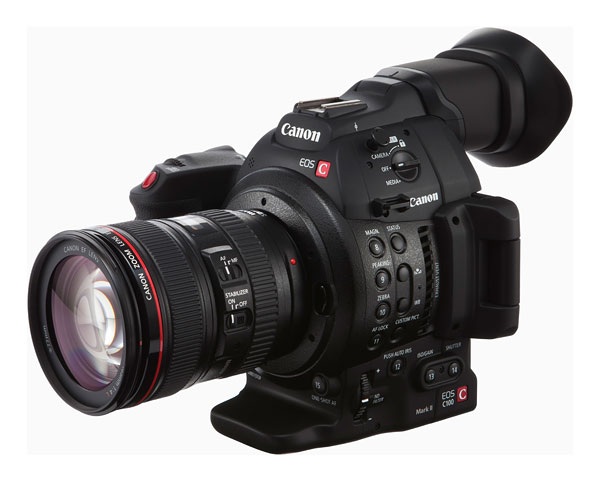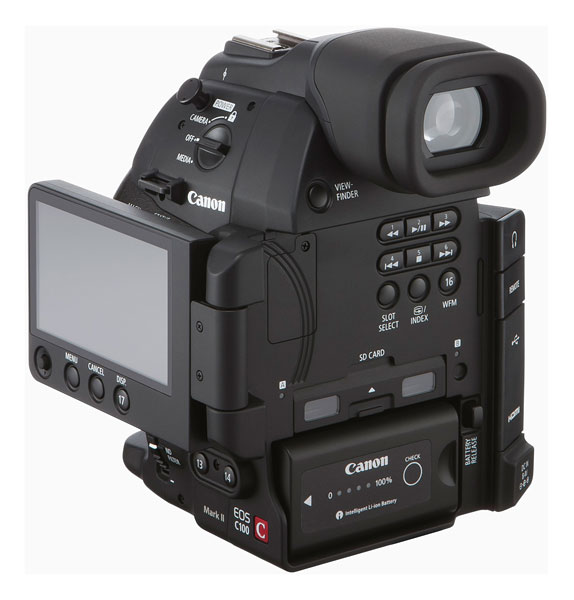Canon Cinema EOS C100 Mark II arrives with Dual Pixel CMOS AF, Wi-Fi, faster processor
posted Thursday, October 23, 2014 at 3:12 PM EST

Movie shooters, take note: Canon has just overhauled its entry-level interchangeable-lens digital video camera, the EOS C100. The new Canon Cinema EOS C100 Mark II brings with it quite a few useful upgrades, while the original C100 gets an instant rebate that makes it more affordable than before.
Of course, "more affordable" and "entry-level" are relative terms here -- the market for dedicated ILC movie cameras is relatively small and made up predominantly by pros, so prices are significantly higher than for typical SLR or mirrorless still cameras which also offer some movie shooting capability. The new EOS C100 Mark II lands at the same US$5,500 pricetag as its predecessor, while the EOS C100 now lists for US$5,000 after instant rebate.
So what's new in the Canon EOS C100 Mark II? The 8.3-megapixel, Super 35mm CMOS image sensor now includes Dual Pixel CMOS autofocus straight out of the box, where for the earlier C100 this was an optional US$500 upgrade that required your camera be returned to a Canon service center for installation. With the new sensor straight out of the box, the EOS C100 Mark II will save videographers money while providing faster smoother autofocus.

The new sensor is accompanied by an upgraded DIGIC DV4 image processor in place of the previous-generation DIGIC DVIII, and Canon says the new variant will improve image quality in several ways. Firstly, it now splits the RGB sensor output into separate red, green and blue channels interpolated to the 8.3-megapixel output resolution of the camera using a new debayering algorithm, before processing with new noise reduction and moiré-reduction algorithms. The result should be a cleaner video signal that's less prone to aliasing and false-color effects. The EOS C100 II's sensitivity range of ISO 320 to 80,000 equivalents is unchanged, however.
The change of processor also allows use of AVCHD and MP4 at up to 1080p60 (59.94 progressive-scan frames per second), with bit rates of 28Mbps for AVCHD or 35Mbps for MP4 capture. By contrast, the original EOS C100 only records in AVC with a maximum bitrate of 24Mbps and interlaced 1080i60 or progressive-scan 1080p30 at best.

Also new to the EOS C100 II is a built-in lookup table that allows wide dynamic range or BT.709 signals either on the camera's own rotating 3.5-inch display or the HDMI output. And the display itself has been upgraded, too, now using a 1,230,000 dot Organic LED panel rather than the earlier 922,000 dot LCD panel. Also tweaked is the articulation mechanism, which now allows users to close the display facing inwards, for a modicum of extra protection.
The electronic viewfinder has also been completely redesigned, and is now based around a 0.45-inch display rather than the C100's 0.24-inch panel. It isn't clear how the resolution compares, though. Previously, Canon used a 1,555,000 dot panel, but the replacement is described as being "1.23 megapixel" -- which could be referring either to dot or pixel count. Assuming the latter, that's around 2.4x the total pixel count of the C100 panel. The new EVF also has a larger eyecup, and the whole eyepiece tilts for shooting from awkward angles, too.

Another important addition is Wi-Fi wireless networking connectivity, which allows for in-the-field viewing and remote control on smart devices, as well as for backup and even transfer to an FTP server. Canon has also tweaked the controls, coloring trigger buttons red to make them stand out, and adding a built-in monaural microphone to stand in for the removable stereo microphone, which doubles as a top handle. Additional changes include face-detection autofocus, 17 assignable, recessed function buttons, a clear plastic cover over the dual SD card slots, and a simplified battery latch mechanism.
The Canon EOS C100 Mark II ships from the end of December 2014, priced at US$5,500 list.